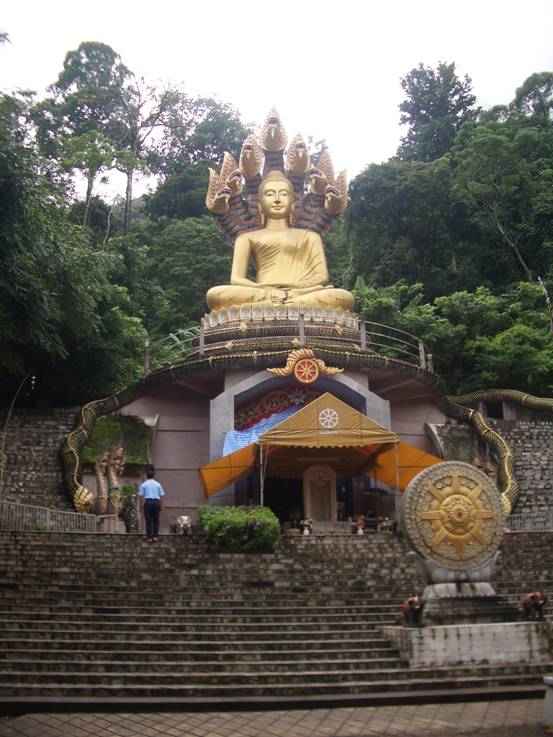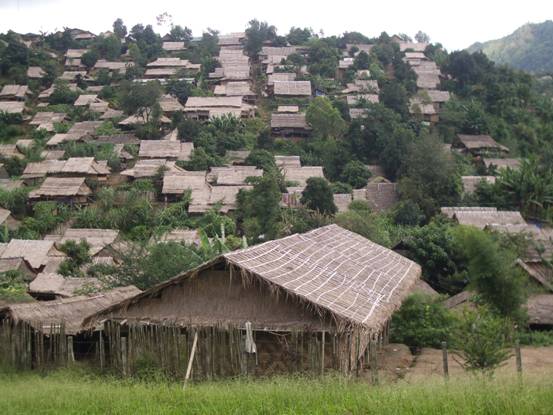A Visit to Mae Sot on the NW border with Myanmar
Despite having lived in Thailand for three years and visited for ten, the geographical horizons of my experience have been fairly limited, though enjoyable. Recent purchase of a car and the positive impressions of a French English teaching colleague persuaded
me the visit to Mae Sot was a must, so on the recent long weekend it was time to go – with my stepdaughter Bow and my French friend. What a wonderful and moving experience. We left after school on Wednesday afternoon and drove all the way
to Tak (pronounced Dtaak).
For the most part I am happy enough with my life in Isaan, but scenic paradise it is not. To be sure, now the rainy season is finally underway (very late!) the arid red-brown and mostly flat landscape has turned verdant green. But a little more than an
hour west the scenery changes to the mountains and forests of a succession of national parks and I wonder how I neglected them so long. The mountains drive begins just out of Chumpae, ends just before Phitsanulok, and the scenery is breathtaking.
We had a long journey ahead of us so we didn’t stop but it was a truly majestic drive.
By the time we arrived at Phitsanulok around 8.30pm we were famished so we stopped for pizza…we paid the price. Nothing wrong with the pizza but by the time we left the heavens had opened, and the monsoon rains reduced our speed to an average 50km/h
so that the last leg to Tak took two and a half rather than the expected one and half hours. We found a hotel with fan rooms at 11.30pm for 340 THB a night – quite adequate on a rain-cooled night and we slept well. Tak is a river
town and possibly worth a day exploring but we had other vistas to explore and by 8am were on the final 90km to Mae Sot on a beautiful mountain road. We passed though three or four army and police checkpoints with barely a cursory glance
– the checkpoints are to prevent illegal movement of Burmese refugees, although they scarcely achieve that. The drive is simply stunning, and despite the rainy season morning fog we were in frequent awe at the mountainscapes, before
arriving at one of the nicest mountainside temples I have seen. Unlike so many, the modest complex is not surrounded with scaffolding and has a lovely symmetry of form.
The temple has a sensational rocky backdrop.
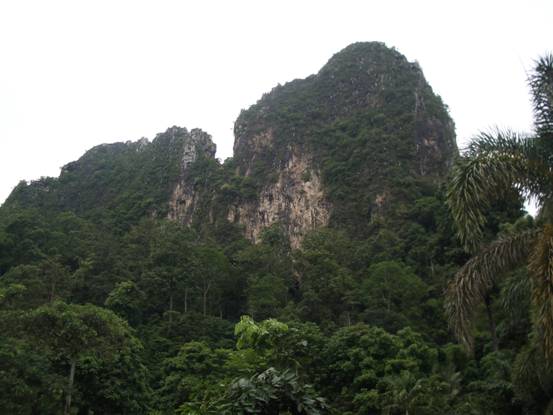
Mae Sot is home to about one hundred and fifty thousand Burmese refugees. They are illegal but the scale of the problem is such that the Thai authorities seek to contain them there rather than stop them entering. Mae Sot is a town of contrast between
the miserable conditions of the refugees and the considerable sums of money the Thais are making off their backs. The traffic jams are not quite Bangkok in scale but the traffic density is incredible for the size of the town. Many of the refugees
work illegally or sometimes legally in Thai factories for 2000 THB a month out of which they must pay off the Thai military and police a standard 500THB a month to avoid detention and deportation.
A variety of circumstances await those who have escaped from Myanmar for all kinds of reasons: some purely economic, some literally to save their lives: there are children here who have lost both their parents to the Burmese military and who have navigated
the jungle and swum the river to avoid enforced military conscription as young as 12. There are large refugee villages that are now well established in the mountains surrounding Mae Sot – these mostly have running water and even electricity
two or three hours in the evening only. But the refugees are trapped there, movement is strictly controlled, they are not allowed schools, they cannot legally work, and there are people who have been in these camps under these conditions for
decades.
This particular village is called Umphien and is about two hours drive south from Mae Sot. A far larger village lies on the mountain road to Chiang Mai – it houses over 50,000 refugees and is guarded by multiple checkpoints. Nevertheless people
routinely find their way through these checkpoints to work illegally in other locations: human traffickers charge about 20,000 THB to take someone from here to Bangkok.
There are farm workers in the mountains – I was not sure if they were legally Thai Karens working on their own land or as labourers on Thai land (more likely I suspect) or even refugees providing cheap labour. It is incredible to see how they can
till and plant all kinds of crops on the steep mountainsides. I had never seen rice on an unterraced mountainside before, but it was a common sight, along with corn and a wide variety of vegetables: here some kind of cabbage. The soil seems
to be reasonably fertile, stable and free-draining but fertilizer is still required and it was amazing to see on closer inspection, every plant with a little cow manure – imagine lugging sacks of that on your back up these hillsides.
The tilling is also entirely by hand – it is far too steep for any kind of tractor.
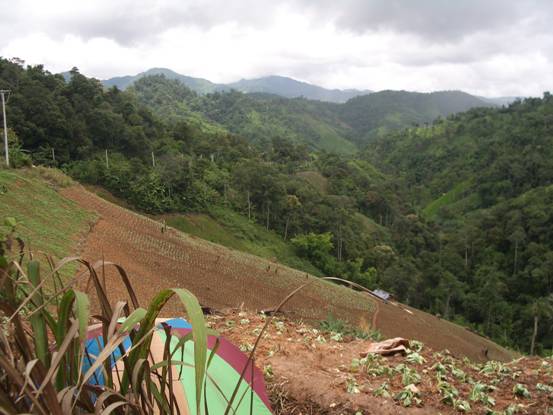
At this mountain farm site with the workers barely in sight in the distance, we stopped and found these children alone and unattended, while their parents worked more than 500 metres away. The older children were curious but the baby was terrified at
the sight of my white face until my daughter Bow provided calm. I would have been terrified that they might fall down the hill – and in a Western country they could have disappeared with a passing pervert, but here I guess the parents just
don’t have any option: all hands that can work must and those that can’t look after each other.
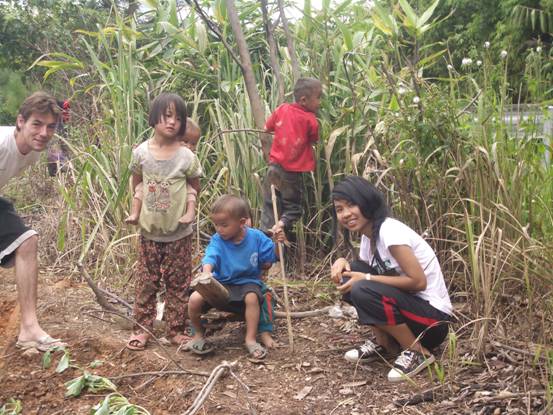
The drive to Umphien is difficult but worthwhile – it is not possible to enter the refugee village without a special permit but the drive is breathtaking. In the middle of apparently nowhere, not a car to be seen, and few people we came across
quite a few motorbikes with sacks of bamboo shoots dug from the forest for consumption. My brother in law grows this stuff for the local market – but the wild variety in the mountains here is in huge supply and greater size.
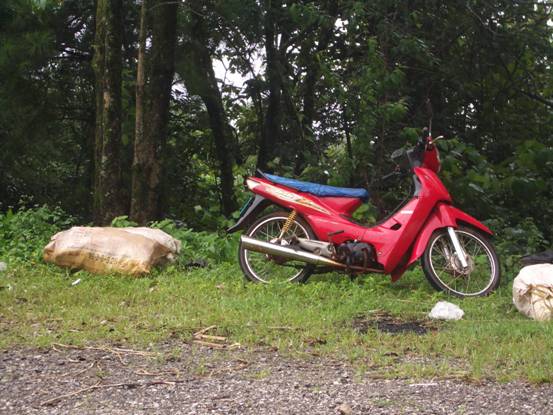
Testimony to the road’s solitude was this amusing sight: in Isaan we routinely have sleeping dogs on the road but I have never seen cows sleeping on the road. They didn’t flinch when I drove around them and just stared at me when I took
the photo.
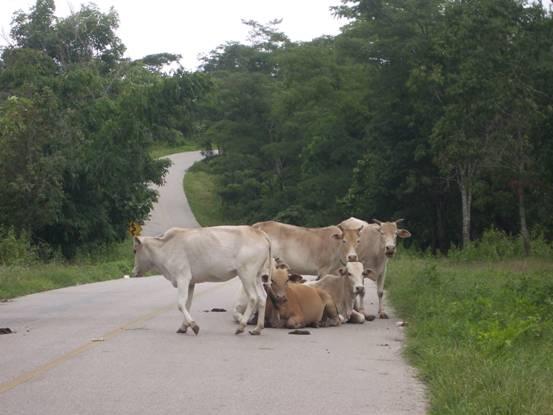
Right in the heart of Mae Sot is an appalling slum inhabited mainly by Muslim Burmese. We didn’t make it there this time. Actually a visit to the border market is all that is required to see how relatively intolerable living in Myanmar must be
to so many who choose to live instead illegally on the Thai side of the river like this:
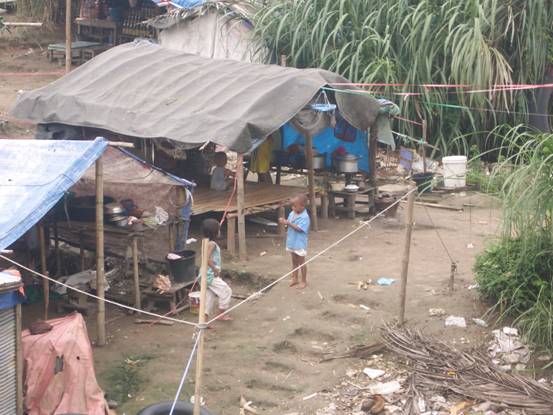
The squalor extends all along the river and indeed the Burmese routinely swim the river within full sight of the soldiers on the Friendship Bridge, now closed ostensibly due to a dispute about Thai management of the riverside but in all probability, actually
to shield the Myanmar military from scrutiny of another ruthless crackdown on the hill tribe villages just before the election.
There are also a number of enterprising traders who swim the river daily to sell illegally, duty-free cigarettes to both Thais and tourists on the Thai side. Like everything in Thailand there is the appearance:
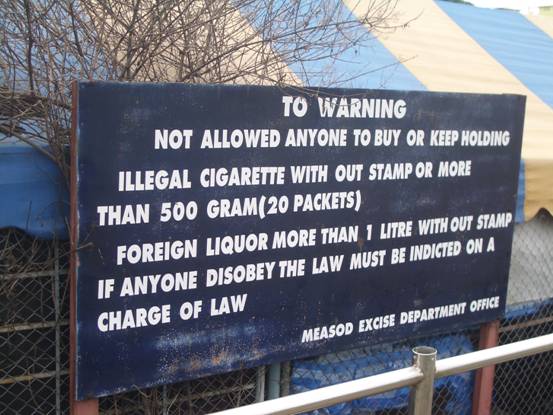
And the obviously different reality:
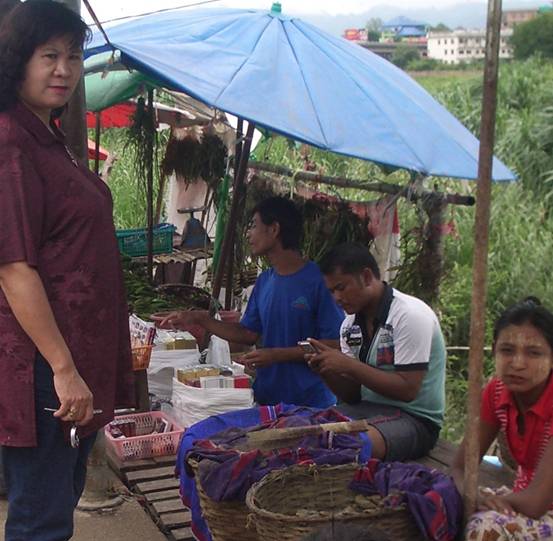
The traders’ wares comprise cartons of cigarettes, porn books and DVDs. By the way, the market on the border is well worth a visit. The teak furniture is fantastic – probably mostly made from Burmese teak smuggled across the border. Teak
is a lovely timber and the workmanship achieved from fairly primitive tools is astounding – particularly the carving. Here are some typical Burmese woodworkers producing hand made furniture.
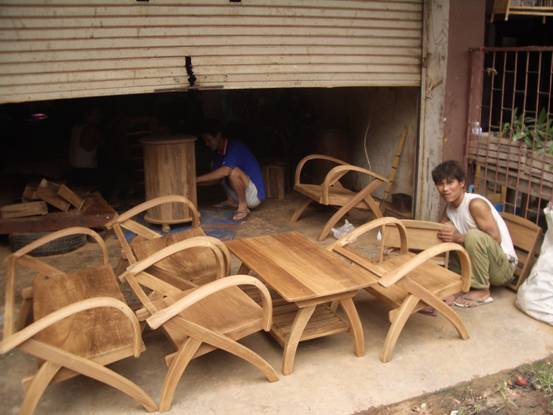
Good accommodation is plentiful in the town and its surrounds with a number of reasonably priced guesthouses catering to the hordes of NGO volunteers and backpackers. We stayed in the Phannu on the main road – fan rooms for 300 a night and air
con for 400, much cheaper and still clean and comfortable are available, but we liked where we were. There are also quite a number of more upmarket establishments – although the “resort” claim many made seems a bit extravagant.
I didn’t inquire about their prices but suffice to say the town caters for all budgets and there are long-term volunteers who survive on 10-12,000 THB a month and still manage an occasional bus trip to Bangkok.
There is a small selection of farang friendly restaurants. Our favourite for breakfast was Aunty’s Coffee – which had a good selection on the menu with even the big breakfast under 100 baht, excellent coffee, a selection of teas, and delicious
yoghurt smoothies – the first decent one of those I have ever had in Thailand! Halfway between the Phannu and Aunty’s is a Burmese restaurant Aiya run by a long term Karen refugee and ex freedom fighter, now married to a Thai
and running a school for refugees. Burmese food can be a little oily and is generally not as spicy as Thai food: the flavours are more subtle and I found them quite pleasant. My favourite dish there was the tealeaf salad – an interesting
and delicious mix of flavours. They have live entertainment on Friday and Saturday night – farang nostalgia mostly. Across the road is the Baifern, a very tastefully decorated restaurant with ferns growing up a running water window.
In addition to the main food menu they have a small selection of cakes served with icecream. The Burmese staff need some more training though, my French friend ordered a black coffee and received a whisky based cocktail of some sort instead.
Another popular restaurant – especially for those with a big American appetite is the Krua Canada with a very large selection of great burgers and bagels, toasted sandwiches on wholegrain and rye breads, and full-size Western meals
including NZ lamb chops, which can be washed down with a drinkable South African red, all at very reasonable prices. Their chocolate icecream sundaes are pretty good too! Just wish the Canadian host would smile a little more – he seems
a decent enough guy when you talk to him but his gruff exterior is a little offputting at first. Finally, for cheap, cheerful Thai meals there are a number of eating places in the night market including one which has clearly become the favourite
dinner destination of NGO residents and backpacking visitors alike. I had an excellent spicy beef salad with beef I could actually chew – a rare experience in Thailand. The host clearly enjoyed giving Thai lessons to the eager newbies.
The Baifern Restaurant front window.
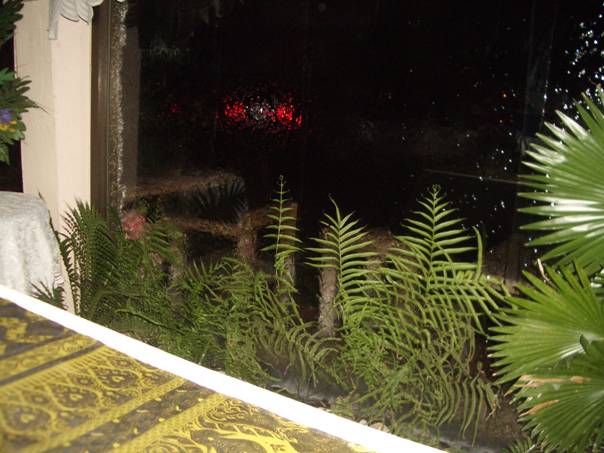
Before talking about the nightlife I should comment on the kind of farang encountered there. The first dual impression is how much younger and how many more women than I have seen anywhere else in Thailand. The thing that impressed me was what really
nice people most of them seemed to be. I didn’t get one sour accusing look from a Western woman there while dining alone with my Thai teenage daughter: instead I got smiles and found it easy to strike up conversations with them. I have
more than once disparaged Western women as having big noses and big asses and to be sure there were quite a few of these in evidence, but also some very lovely looking ladies as well. At the Thai restaurant we struck up a conversation with a young
French woman who was teaching French at a refugee school while on a holiday and her recently arrived backpacker companion, and later we all headed off for drinks together.
Pattayaphiles will not find the nightlife of Mae Sot appealing. There is a smattering of farang friendly bars but these are not open very late, offer nothing much in the way of entertainment and don’t even have a decent selection of beers, although
one does offer a wide range of not particularly authentic cocktails. These mainly serve as meeting or networking venues for various NGO workers volunteers and backpackers. It was only about 11pm when on a Friday night Julien and I went looking
for a drink, and found nothing open except a Thai oriented karaoke bar upstairs on one of the two main streets. If you could endure the karaoke in the main room, beer was available at reasonable prices and the company of a Burmese lady could
be purchased for 80 baht an hour. The usual private karaoke rooms were in evidence off to the side – inhabited usually by several drunk Thai men and one or two Burmese companions. In conversation with one of the girls we were advised
that all night was available for 1500 baht, presumably paid in the establishment.
There is also a small red light district with about 4 or 5 somewhat boring bars supplied again with Burmese prostitutes. We investigated and found very few customers, and most were Thai although the girls claimed to have periodic farang visitors. This
was all okay with us as we didn’t go for the nightlife.
Mae Sot is home not only to more than 150,000 Burmese refugees but to many very poor schools set up to serve the needs of their children. The schools are actually illegal but the authorities don’t seem overly concerned about them. We visited three
of these schools: a wonderful and very moving experience. The first school we visited is perhaps more established than many with a number of buildings and more than 200 students of whom 90 or so are in permanent residence, presumably because they
are not with their parents or their parents are dead. These schools get some funding and assistance from various NGOs and their food from agencies like the UN: but the children there don’t get clothes, soap, and personal necessities.
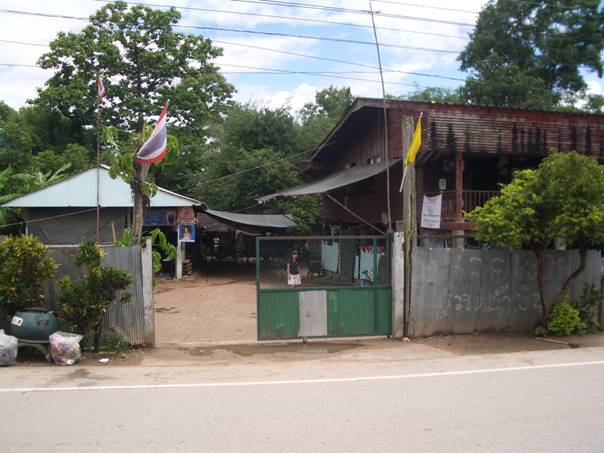
The school equipment is beyond basic. These rooms double as classrooms and girls dorms:
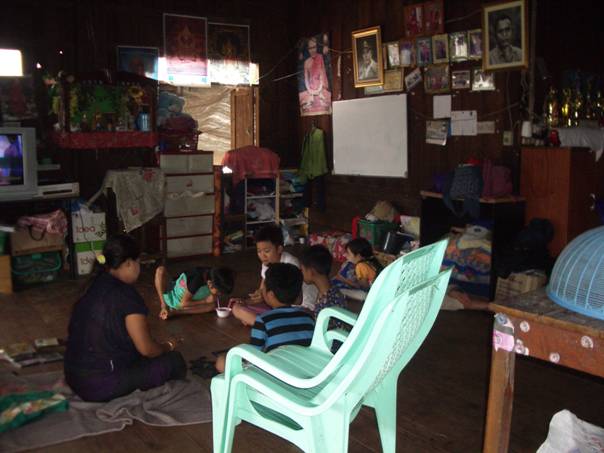
The boys have it a little tougher – this was their dorm:
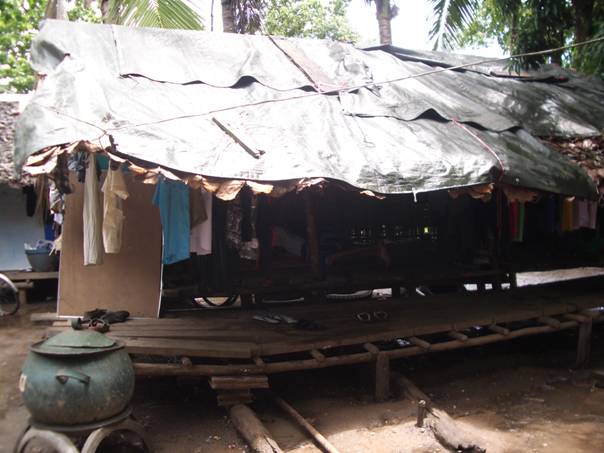
But you will never meet nicer, more motivated students than these Burmese have-nots who dream of UN scholarships and study with passion to earn one. Many of the schools are without desks, there are few or no textbooks, and the teachers are mostly volunteers
passing through with nothing but goodwill to guide them: yet these students typically speak English two years out of the jungle far better than any of my Grade 12 Thais. If teaching in Thailand has destroyed the passion you once had, go to Mae
Sot, volunteer for six months and re-discover all the joy that teaching can bring. The sad thing of course is that only a very small proportion will gain that coveted UN or NGO ticket to a real university and a better life. The others remain trapped
in Mae Sot with no passport or ID card, forbidden to travel or to work, except to be exploited in the Thai-owned local factories or perhaps worse in the Thai owned brothels. I found myself wrestling with the question – is it right to open
these schools and give the students such high hopes when for most they are unrealistic? My friend Julien reminded me that the occupation of study is better than no occupation, a slim hope better than no hope, and the mental skills acquired in
learning all sorts of perhaps directly irrelevant subjects may translate into enhanced opportunism, resilience, social interaction and so forth. I think he’s right. Don’t sit in your armchair and write me an email about what you
think. Go there, engage with these kids, then tell me they should be abandoned to idleness or the local version of the vaunted free market!
The second school we visited was a small vocational training school where the students study to meet the global graduation standards while learning practical skills and undertaking various projects to generate the necessary money for the school to survive.
Currently the school has large orders to construct steel water towers, and others from local schools to construct desks. The photo shows students assembling one of the water towers they have constructed.
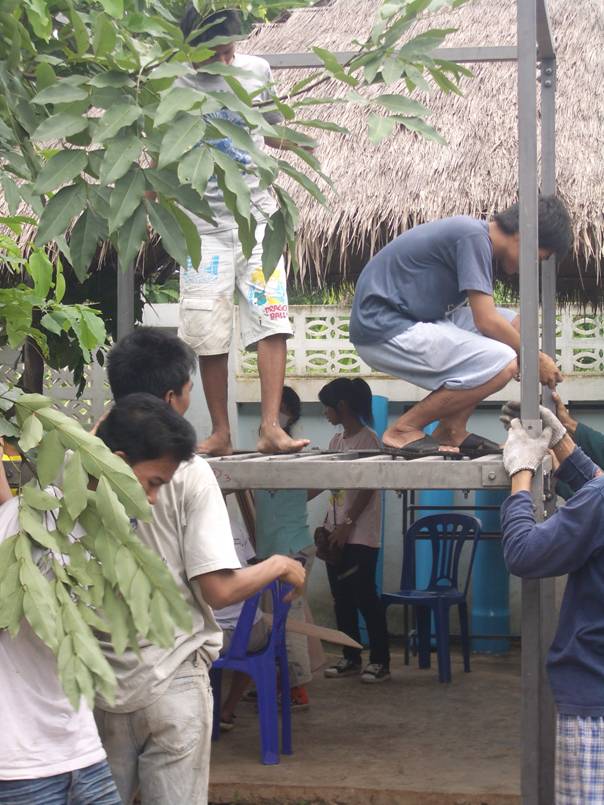
It was holidays when we visited but all the students were there working on the projects. We were privileged to attend a welcome party they had organized for new Burmese teachers – themselves refugees who had gained scholarships to train as teachers
in a university in Bangladesh and had come to this school to complete their teaching internships. Julien had previously worked at this school teaching woodwork and both students and teachers were pleased to see him. The photo shows the students
and some teachers in the workshop, the boys dorm is directly behind.
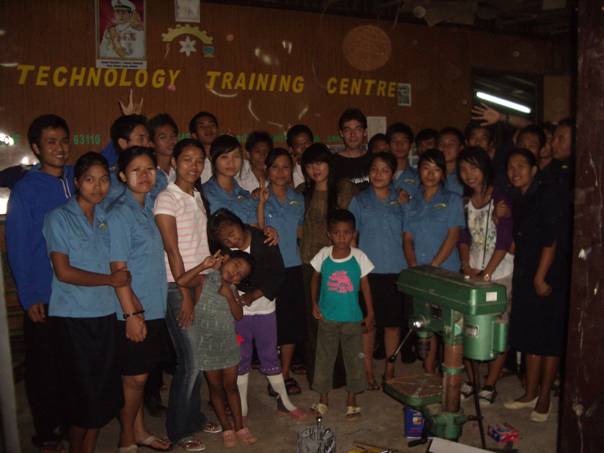
All were gracious hosts, my daughter stayed with the girls in their dorm on our last night – she didn’t want to leave the next morning.
The third school we visited on our way home – it was a fleeting visit, sufficient to see far more primitive conditions than in the previous schools – outdoor classrooms with on the ground seating and a small whiteboard only. Then it was
time for the long trip back to Khon Kaen. I found myself wishing I had not sunk such deep roots in Isaan: my life on the little homestead and my teaching job are for the next few years mutually dependent but with a change in School Director my
aspirations for lifting the standard of English are looking increasingly forlorn, and it is hard to give heart and soul for Thai students who perceive no real need to exert themselves to learn. But for now I need to persevere while making whatever
contribution I can to these willing but needy refugee students on the other sides of Thailand. Perhaps there may be some past teachers out there willing to donate teaching materials, grammar books and the like to provide the volunteer teachers
and the students there alike with small reference libraries. If so please email me.
Stickman's thoughts:
Absolute top drawer trip report. Wow! I love these reports that you really get into, that take you away to a place that you have never been and that as you realise it's coming to and end, you know that you don't want it to end.
